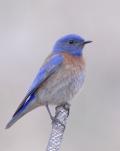We studied the nest-site characteristics of Western Bluebirds nesting in natural tree cavities in burned and unburned logged ponderosa pine forests along the east-slope of the Cascade Range of Washington, 2003–2008 and 2010. We compared 13 bluebird nest-site habitat variables between burned and unburned stands by assessing overlap in 95% CI. Tree density (number of live trees >25.4 cm diameter at breast height/ha) and percent debris cover (litter and large woody debris) were greater at nest sites in unburned stands and they were the only nest-site characteristics that differed between the two treatments. Cavity orientation in burned stands was not uniformly distributed and the mean direction was 121 degrees; whereas cavity orientation in unburned stands was uniformly distributed. Ponderosa pine contained the most cavities (82%) followed by Douglas-fir (11%), while the majority of substrates containing bluebird nest cavities (73%) had advanced decay and broken tops. Of the cavities bluebirds used where the original excavator was known, 27% were excavated by Hairy Woodpeckers, 12% by White-headed Woodpeckers, and 5% by Northern Flickers. Only one nest was located in a non-excavated cavity. Of the 38 second nest attempts, 76% occurred in the same cavity as the first attempt even though 38% of these first attempts were unsuccessful. Our results suggest that bluebirds are using similar nest sites in burned and unburned ponderosa pine stands and that they rely almost entirely on primary excavators to create the cavities they use for nesting.
Our goal of this study was to describe and compare the characteristics of nest trees or snags and other fine-scale habitat features associated with Western Bluebird nest sites in burned and unburned treatments; and 2) determine the proportion of excavated and non-excavated cavities used by bluebirds for nesting.
The project plan entails searching for Western Bluebird nests, monitoring the nests to determine fate, then measure vegetation (habitat) variables associated with the nest sites. After field sampling is completed, the data will be analyzed and the results written up into a manuscript for publication in a peer-reviewed journal.
This project was completed in 2010. The data was analyzed, results were written up into a manuscript, and the manuscript submitted to the journal Western Birds for publication in 2014. The manuscript was accepted for publication and a link to a .pdf version of this published paper can be found below.
Status: Completed
05/01/2003 to 08/31/2010Project Manager
-
Jeff Kozma ,
Timber, Fish and Wildlife (TFW), Wildlife Biologist
509-865-5121 x6343

